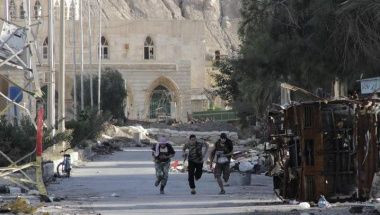Syrian Intervention: Risk Of Arming Radicals Depends On The Weapons

President Barack Obama’s decision this week to escalate the U.S. involvement in Syria by arming rebel forces comes with the serious risk that the weapons may end up in the hands of Islamic radicals and even al Qaeda -- a problem the president reportedly weighed for months as he contemplated U.S. involvement in the conflict.
The best way to minimize the perils of arming anti-American forces in the Middle East is simply to withhold the most powerful weapons, experts say. But that carries its own risk: providing only low-level munitions could also fail to turn the tide against Syrian President Bashar Assad’s forces.
That appears to be the path Obama is taking, at least right now. White House officials have not outlined what weapons they intend to give the forces led by the moderate Brig. Gen. Salim Idris, the chief of staff of the Supreme Military Council of the Free Syrian Army, but observers believe the provisions will be limited to basic arms, such as machine guns. The administration has not committed to providing the more sophisticated antitank and antiaircraft weaponry the rebels say they need to defeat regime forces, according to the New York Times.
“There’s a sliding scale, right, small arms and ammunitions are at the lowest end of the risk, obviously, because those things are already highly proliferated,” said Shawn Brimley, who served as the director of strategic planning on Obama’s National Security Council for two years before rejoining the Center for a New American Security as its vice president and director of studies. “Jihadists and terrorists, they already have access to AK-47s and bullets. That’s not something anyone’s going to be concerned about. But it’s when you get in the more sophisticated stuff that you have to be way more concerned about the prospects for proliferation.”
The U.S. faces a difficult task in aiding the rebel forces, a factious group with both moderate and extremist components. Short on resources and even small-scale weapons, the rebels’ situation is becoming dire. Due to the risks of introducing the more sophisticated weapons, experts predict the administration is trying to intervene on a small scale by providing only those low-level munitions.
“The last time we did this was we gave a whole bunch of Stingers [anti-aircraft missiles] to the mujahedeen in Afghanistan: A lot of those things are still out there, and they’re not all in the hands of people we are comfortable with,” said Paul D. Eaton, a retired U.S. Army major general who now serves as a senior adviser to the progressive National Security Network. Eaton said providing low-level arms and resources such as medical supplies is “appropriate” -- unlike shoulder-fired anti-aircraft missiles.
For that reason, Brimley said he doesn’t believe the administration will ever provide those more sophisticated weapons to the rebels, pointing out that, in the wrong hands, they could be used against Israel or even to threaten commercial airline flights. “If we ever walk down that path, the U.S., I’m sure, will insist on having some sort of positive human control,” which he described as putting teams of U.S. intelligence workers on the ground to oversee the weapons. “It would have to be a far more intensive, intelligence-led operation, so I don’t think we’re going to go down that road,” Brimley said.
Due to the risks of proliferation, the U.S. appears to be trying to “compromise” by sending only low-level arms, said Marina Ottaway, a senior scholar in the Middle East program at the Woodrow Wilson Center. “But I’m not sure it will work because I think what the rebels need [are] the anti-aircraft and anti-tank weapons.”
Ottaway indicated she believes the U.S. government may employ a second strategy -- besides simply limiting the type of weapons it sends -- to keep the arms from the more radical factions of the rebel forces: sending the weapons through Jordan into southern Syria, where there appears to be less infiltration by radical elements. “Channeling the weapons through Jordan is probably another way to minimize the risk that the weapons will fall in the wrong hands,” she said.
Still, the consensus is that sending only low-level weapons may not be enough to turn the tide and ultimately lead to Assad’s ouster. Which raises the question of what the actual foreign-policy objective of the escalation is?
“Is the goal to defeat the regime?” Brimley asked. “Is the goal to give the rebels a fighting chance? Is the goal to maintain a level of stability between the armed sides that could increase pressure for a negotiated settlement? ... Is the goal to counterbalance Iran’s flow of munitions as well?”
According to Brimley: “The worst outcome is we give rebels munitions they don’t really want or desire and doesn’t really make a material difference. So we’ve introduced U.S. credibility into the conflict, but you haven’t gained anything truly decisive and strategic and the rebels continue to be -- essentially be -- mad at us because we’re not giving them what they want. This is the challenge.”
© Copyright IBTimes 2025. All rights reserved.





















